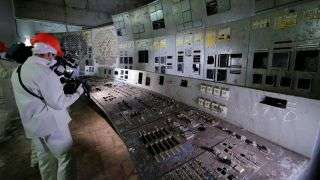
On Sept. 15, a group of journalists visited the control room of the Chernobyl nuclear power plant’s reactor 4.
Tourists can now visit the control room of Chernobyl’s Reactor 4, the scene of the world’s worst nuclear disaster. But the control room is still highly radioactive, and people are required to wear protective gear when inside, according to recent news reports.
Ukranian President Volodymyr Zelensky declared Chernobyl an official tourist attraction in June at the inauguration of a gigantic dome built to contain radioactive material. But Chernobyl has been a tourist destination for far longer — parts of it having been open to the public for nearly a decade. In May, bookings to Chernobyl increased by about 30% following the release of the popular HBO series of the same name, according to a previous Live Science report.
But Reactor 4 had remained closed off to most of the public, save for a few researchers and cleanup workers. Now, Chernobyl tour companies have confirmed that the control room is open to the brave souls who wish to be closer to the scene of the disaster, according to CNN.
The control room, which was highly damaged from the explosion, was where the reactor was operated from and where many of the decisions the day the reactor exploded, were made. It sits under the new containment arch but outside of the original sarcophagus that contained the radiation of the reactor itself, according to the Telegraph.
The radiation in the room is 40,000 times higher than normal levels, according to Ruptly, a German news agency. Anyone who wishes to visit the site must wear a protective suit, a helmet and a mask, and limit their visit to 5 minutes. Afterward, visitors are required to undergo two radiology tests to measure the amount of radiation they were exposed to, according to CNN.
That’s typical of most tours in Chernobyl; people must go through radiation checkpoints at the beginning, middle and end of one-day tours, according to a previous Live Science report. Tourists are not permitted to wander on their own; they must stay with the tours because of ongoing radiation concerns.
Other parts of Chernobyl remain off-limits, including the “machine cemetery” in the Rossokha village, which is where the contaminated machines used during the Chernobyl cleanup were dumped, according to CNN. Exposure to large amounts of radiation can cause tissue damage and acute sickness, as well as increase the risk of cancer. However, Ukranian officials have deemed the areas that are open to tourists to be safe, as long as they follow the rules.
Sourse: www.livescience.com





